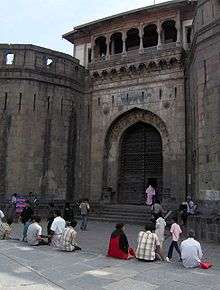Anandibai
- This article is about the Peshwa Queen. For the Indian doctor, see Anandi Gopal Joshi
Anandibai is infamous in Maratha history for successfully plotting the death of her nephew - the 17-year-old king (or Peshwa) Narayanrao. Her husband Raghunathrao was acting regent and next in line for the throne, at the time of Narayanrao's death.
Early life and Marriage
Anandibai was born into a Chitpavan Brahmin family belonging to Guhagar village in the Konkan region of what is now Maharashtra state. She was the daughter of Raghu Mahadev Oak.[1] Her cousin Gopikabai (of the Raste family), was the wife of Peshwa Balaji Bajirao. In December 1756, when Anandibai was yet a child, she was married to Raghunath Rao, younger brother of Balaji Baji Rao.[2] She was his second wife. Raghunathrao's first wife (Janaki Bai of the Barwe family) had died in August 1755.
Both Balaji and Raghunath were the sons of Baji Rao I, Peshwa of the Maratha Empire. The position of Peshwa was an administrative appointment made by the Chhatrapati (King), and it was not actually hereditary. Indeed, Baji Rao I was only the second man from his family to be named Peshwa.
Murder of Narayanrao

After the death of Madhavrao I in 1772, his brother Narayanrao was to take the throne but he was still a minor. There was debate among the Peshwas about who should become the next regent. Finally it was decided that Narayanrao would be the peshwa with his uncle Raghunathrao acting as regent. Initially this arrangement worked but soon Narayanrao imprisoned his uncle on charges of plotting to overthrow him.
On 30 August 1773 in Shaniwar Wada,[3] in an effort to free himself, Raghunathrao hired Gardis as mercenaries. These men scaled and captured Shaniwar Wada. They quickly reached Narayanrao's chambers and held him captive. Narayanrao tried to appeal to his uncle but Anandibai intervened and did not allow his requests to reach Raghunathrao.
According to legend, Anandibai reworded the letter of Raghunathrao, initially bearing the words Narayanrao la dhara (capture Narayanrao) to Narayanrao la mara (kill Narayanrao). This finally led to the death of Narayanrao.[3]
Aftermath
After Narayanrao's death, Raghunathrao became Peshwa but Nana Phadanvis ordered an investigation into the death of Narayanrao. The Chief Justice(Mukhya Nyayadhish) of the Marathas - Ram Shastri Prabhune found Anandibai and Raghunathrao guilty of murder. A part of the letter of Raghunathrao's order to the Gardis was examined by Ram Shastri who determined that the initial order "restrain him" (tyaala dharun aana) had been changed to "kill him" (tyaala marun aana) - a difference of only one letter in the Marathi language. Radhunathrao swore that he had not ordered the murder of his nephew. It was widely believed in the palace that the author of this change was Anandibai herself.[4][5]
Anandibai's husband was overthrown by Nana Phadanvis and 12 others in the Barabhai conspiracy. The result of this was that the one-year-old baby Madhavrao II, born to Narayanrao's widow, Gangabai (Sathe)after his death, was put on the throne, effectively putting the power in the hands of Nana Phadanvis.
Later life
As she and her husband were fleeing from the forces of Nana Phadanvis, she gave birth to Bajirao II on 10 January 1775 in the Dhar fort, under the control of the Pawars.[6]
On 11 December 1783, her husband, Raghunathrao died [7] leaving behind three sons - two sons who were minors and an illegitimate son of mature age - Jaysingh (or Jaysin) by the concubine Radha.[8] She was not happy with the influence of Jaysingh on Bajirao who was crowned regent so she plotted his destruction. Jaysingh came to know of this and executed her chief advisors. She in turn assembled troops and attacked the Kolaba Fort and imprisoned Jaysingh there. After four months in prison, he escaped, gathered supporters and besieged Hirakot. Again Anandibai led her troops against him and defeated him. Thereafter he fled to Poona but returned and served Anandibai with a resounding defeat.[9] She along with her son fled to Mahad where she died on 12 March 1794.[10]
See also
- Gopikabai (cousin of Anandibai)
- Radhikabai
- Kashibai
- Parvatibai
References
- ↑ Gune, Vithal (1996), Survey and Calendar of Marathi Documents, K.P. Bagchi, ISBN 978-81-7074-166-4, retrieved 2009-01-14
- ↑ Turner, O. (1904), Journal of the Bombay Branch of the Royal Asiatic Society, The Society, retrieved 2009-01-14
- 1 2 |Indian express article about Shaniwar Wada
- ↑ Sen, Shailendra (1994), Anglo-Marath Relations during the time of Warren Hastings, Popular Prakashan, ISBN 978-81-7154-578-0, retrieved 2009-01-14
- ↑ Hasting, Gabriel (2004), Strangers Within the Gates, Asian Educational Services, ISBN 978-81-206-1875-6, retrieved 2009-01-14
- ↑ Vaidya, S.G. (1976), Peshwa Bajirao II and the Downfall of Maratha Power, Pragati Prakashan, ISBN 978-81-206-1875-6, retrieved 2009-01-14
- ↑ | Nashik District Gazetteer
- ↑ Desai, Sanjeev (1990), The Marathas on the West Coast of India, Dept. of Archives, Govt. of Maharashtra, retrieved 2009-01-14
- ↑ Gazetteer of the Bombay Presidency, Government Central Press, 1904, retrieved 2009-01-14
- ↑ Kulkarni, Shripad (1992), The Struggle for Hindu Supremacy, Shri Bhagavan Vedavyasa Itihasa Samshodhana Mandira (Bhishma), ISBN 978-81-900113-5-8, retrieved 2009-01-14